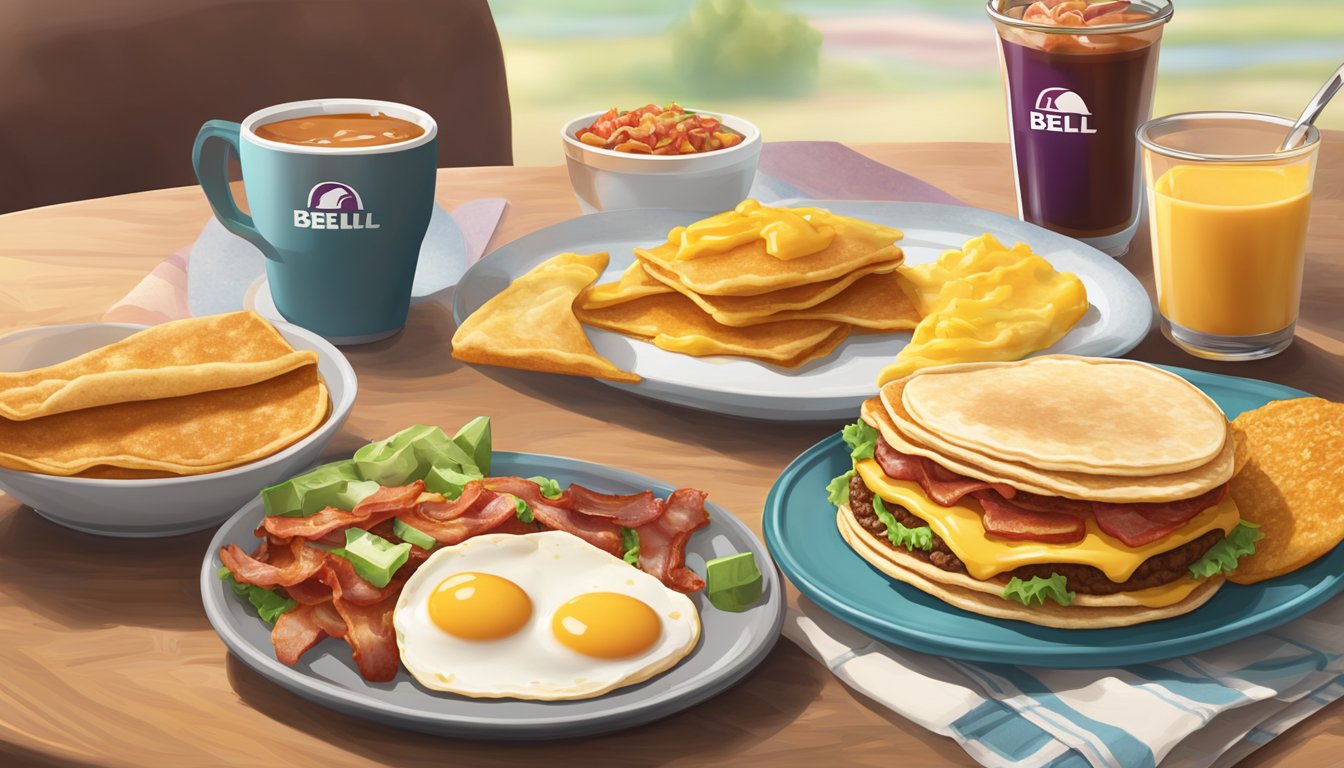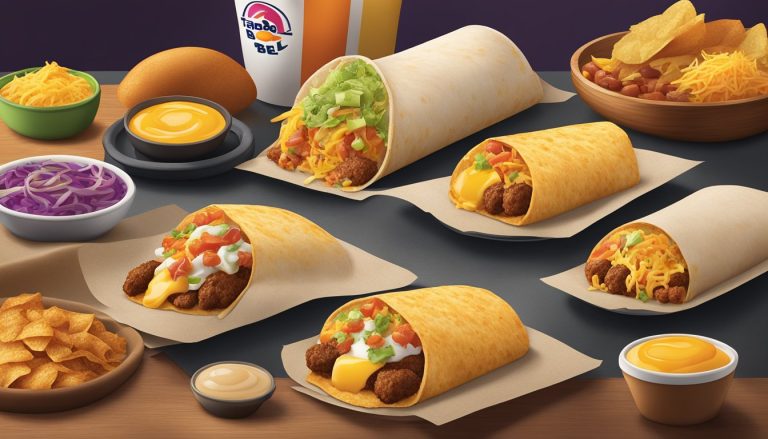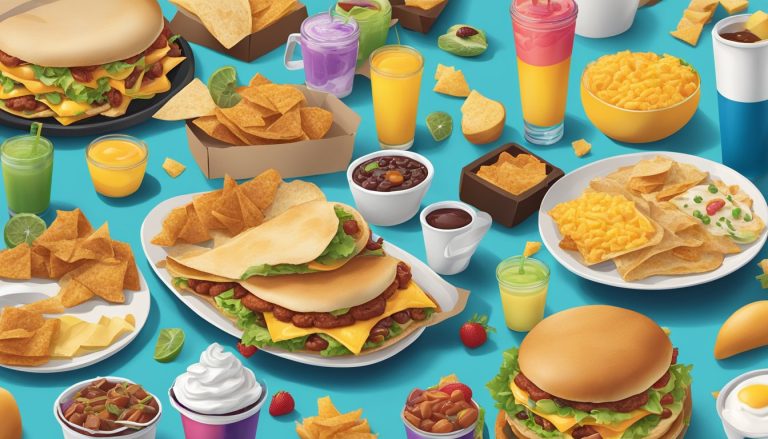Taco Bell’s entry into the breakfast arena has sparked a culinary showdown with traditional American breakfast fare. The fast-food chain’s bold move challenges long-established morning meal norms, offering a unique twist on breakfast that caters to adventurous taste buds.
Taco Bell’s breakfast menu features Mexican-inspired items like breakfast burritos and quesadillas, providing a spicy alternative to classic eggs and bacon. This departure from conventional breakfast options has divided opinion among morning diners, with some embracing the change and others preferring familiar favorites.
The competition between Taco Bell’s breakfast offerings and traditional American breakfast highlights evolving consumer preferences and the growing demand for diverse morning meal choices. As the breakfast battle continues, it remains to be seen whether Taco Bell’s innovative approach will reshape the landscape of morning dining or if traditional breakfast staples will maintain their stronghold in American cuisine.
The Evolution of Breakfast in America
American breakfast habits have undergone significant changes over the decades. From traditional home-cooked meals to fast-food options, the morning meal landscape has transformed to meet changing lifestyles and tastes.
Pancakes and Toast: The Classics
Pancakes have been a breakfast staple in America since the early 19th century. Pioneers heading west made sure to pack flour for this quick, filling meal. Toast also became a popular choice, especially after the invention of the automatic toaster in 1926.
By the 1830s, coffee had secured its place as an essential part of the American breakfast routine. The combination of pancakes, toast, and coffee formed the foundation of a classic American breakfast for many decades.
As the 20th century progressed, bacon and eggs joined these staples, creating the quintessential American breakfast plate.
Rise of Fast-Food Breakfasts
The 1970s saw a major shift in breakfast habits with the introduction of fast-food breakfast menus. McDonald’s led the charge in 1971 with the Egg McMuffin, revolutionizing on-the-go morning meals.
Other chains quickly followed suit, offering their own breakfast sandwiches and platters. These convenient options appealed to busy Americans with little time for sit-down breakfasts.
Fast-food breakfasts expanded beyond sandwiches to include items like breakfast burritos and hash browns. This diversification catered to evolving tastes and dietary preferences.
Taco Bell Enters the Breakfast Market
Taco Bell made its foray into the breakfast market in 2014, introducing a menu that blended Mexican-inspired flavors with traditional breakfast ingredients. Their offerings included unique items such as the Waffle Taco and the A.M. Crunchwrap.
This move challenged the established fast-food breakfast norms, bringing tortillas and bold flavors to the morning meal lineup. Taco Bell’s breakfast menu appealed to younger consumers seeking more adventurous options.
The chain’s entry into breakfast highlighted the growing demand for diverse and flavorful morning meal choices. It also intensified competition in the fast-food breakfast sector, prompting other chains to innovate their menus.
Deconstructing Taco Bell’s Breakfast Menu
Taco Bell’s breakfast menu blends Mexican-inspired flavors with traditional morning fare. It features unique twists on breakfast classics, offering portable options for on-the-go diners.
Signature Breakfast Burritos
Taco Bell’s breakfast burritos are a cornerstone of their morning menu. These handheld meals combine scrambled eggs with various fillings. Popular options include the Cheesy Toasted Breakfast Burrito, stuffed with eggs, cheese, and a choice of bacon or sausage.
For those seeking a heartier meal, the Grande Toasted Breakfast Burrito adds hash browns to the mix. The potato element provides a satisfying crunch and extra substance. Vegetarian versions are also available, substituting meat with beans or potatoes.
Taco Bell’s breakfast burritos come wrapped in a soft flour tortilla, grilled to achieve a lightly toasted exterior. This process enhances the texture and helps keep the contents warm.
Innovative Breakfast Crunchwraps
The Breakfast Crunchwrap stands out as Taco Bell’s most distinctive morning offering. It reimagines the classic breakfast sandwich in a hexagonal format. The standard version includes scrambled eggs, hash browns, cheese, and a choice of bacon or sausage.
A crispy tostada shell in the center adds a unexpected crunch. The entire package is then folded and grilled, creating a portable meal that’s easy to eat on the go. This unique structure prevents ingredients from spilling out while eating.
Taco Bell also offers variations like the California Breakfast Crunchwrap, which adds guacamole for a West Coast twist. These innovative items set Taco Bell’s breakfast apart from more traditional fast-food morning menus.
Sweet Cinnabon Delights
For those with a sweet tooth, Taco Bell partnered with Cinnabon to create Cinnabon Delights. These bite-sized treats consist of donut holes filled with Cinnabon frosting. The exterior is coated with cinnamon sugar, providing a satisfying crunch.
Cinnabon Delights are served warm, allowing the frosting inside to become gooey and indulgent. They’re available in packs of 2, 4, or 12, making them suitable for individual treats or sharing.
These sweet morsels offer a unique alternative to traditional breakfast pastries. They pair well with Taco Bell’s coffee offerings, providing a balanced sweet and caffeinated start to the day.
Traditional American Breakfast Components
The quintessential American breakfast encompasses a variety of hearty and satisfying dishes. Key elements include protein-rich eggs and meats, starchy potatoes, and an assortment of breads and sweet treats.
Eggs and Meats: Versatile Staples
Eggs are a cornerstone of the traditional American breakfast, prepared in numerous ways. Scrambled, fried, poached, or folded into omelets, eggs provide a protein-packed start to the day. Bacon and sausage are popular meat choices, offering savory flavors and crispy textures.
Breakfast sandwiches often combine these elements, featuring fried eggs, cheese, and bacon or sausage on toasted bread or English muffins. These portable options cater to busy lifestyles while delivering classic breakfast flavors.
Ham and steak are also common, especially in heartier breakfast platters. These meats pair well with eggs and add substantial protein to the meal.
Potatoes in Many Forms: From Hash Browns to Home Fries
Potatoes play a significant role in American breakfast cuisine. Hash browns, shredded potatoes crispy on the outside and tender inside, are a beloved side dish. Home fries, cubed potatoes seasoned and pan-fried, offer a flavorful alternative.
Some regions feature potato pancakes or rösti, while others incorporate potatoes into breakfast skillets or casseroles. These dishes often combine potatoes with eggs, meats, and vegetables for a filling meal.
Mashed potatoes occasionally appear in breakfast platters, particularly in diners and family-style restaurants. The versatility of potatoes allows for various preparations to suit different tastes and regional preferences.
Breads and Sweet Treats: Waffles, Pancakes, and Pastries
Sweet components balance out the savory elements of an American breakfast. Pancakes and waffles, often served with butter and maple syrup, are iconic choices. Some variations include fruit, chocolate chips, or nuts for added flavor and texture.
Toast is a simple yet essential item, available in white, wheat, or artisanal varieties. It’s often served with butter, jam, or as a base for avocado toast in more contemporary settings.
Pastries like muffins, doughnuts, and Danish pastries offer quick, sweet options. Biscuits, particularly popular in Southern cuisine, can be served with gravy or jam.
French toast, made from bread dipped in egg and milk then fried, bridges the gap between sweet and savory. It’s typically topped with powdered sugar, syrup, or fruit compote.
Comparing Nutritional Values and Variety

Taco Bell’s breakfast menu and traditional American breakfast options differ significantly in their nutritional profiles and variety. Both offer unique choices that cater to different dietary needs and preferences.
Caloric Intake and Fat Content
Taco Bell’s breakfast items generally contain fewer calories compared to traditional American breakfasts. The Bacon Breakfast Burrito at Taco Bell has 300 calories, while a typical bacon and egg sandwich can exceed 400 calories. Fast food breakfast sandwiches like the Egg McMuffin contain around 300 calories.
Fat content varies widely. Taco Bell’s cheese-heavy options, such as breakfast quesadillas, can be high in fat. However, they often have less fat than traditional American breakfast platters with fried eggs, bacon, and hash browns.
A breakfast burrito at Taco Bell typically contains 20-25 grams of fat. In contrast, a full American breakfast with eggs, bacon, and toast can easily surpass 30 grams of fat.
Protein-Packed Options for Wellness
Both Taco Bell and traditional American breakfasts offer protein-rich choices. Taco Bell’s menu includes items with eggs, cheese, and meat, providing substantial protein. Their steak and egg burrito can contain up to 25 grams of protein.
Traditional American breakfasts often feature eggs as a primary protein source. A two-egg breakfast with bacon or sausage can provide 20-25 grams of protein. Greek yogurt parfaits, a common American breakfast option, offer 15-20 grams of protein.
Taco Bell’s protein options are often wrapped in tortillas, while traditional breakfasts may include protein on its own or with toast. This difference affects overall nutritional balance and satiety.
Vegetarian and Gluten-Free Choices
Taco Bell offers more customizable options for vegetarians and those seeking gluten-free meals. Customers can easily remove meat from most breakfast items or swap it for beans. The chain also provides a veggie breakfast burrito.
Traditional American breakfasts can be vegetarian-friendly with options like oatmeal, fruit bowls, and vegetable omelets. However, gluten-free choices may be more limited unless specifically catered for.
Taco Bell’s corn tortillas provide a gluten-free alternative to traditional wheat-based breakfast breads. Many American breakfast staples like pancakes, waffles, and toast contain gluten, requiring special preparation for gluten-sensitive individuals.
Both menus offer fresh fruit options, but traditional American breakfasts typically provide a wider variety of whole fruits and juices.
Convenience and Accessibility

Taco Bell’s breakfast offering stands out for its focus on convenience and accessibility. The chain has optimized its morning service to cater to busy customers seeking quick, portable meals.
Speed of Service for On-The-Go Customers
Taco Bell’s breakfast service is designed for efficiency. The menu features handheld items like breakfast burritos and Crunchwraps that are easy to eat while commuting.
Staff are trained to assemble orders quickly, often preparing items in under a minute. This speed allows customers to grab breakfast without significant delays to their morning routines.
The packaging is also optimized for on-the-go eating, with wraps and containers that minimize mess and spills.
Availability and Breakfast Hours
Taco Bell offers extended breakfast hours compared to many competitors. While most fast food chains stop serving breakfast at 10:30 AM, many Taco Bell locations serve breakfast until 11:00 AM.
Some Taco Bell restaurants even offer breakfast items all day, catering to late risers or those craving breakfast foods at non-traditional times.
This flexibility in breakfast hours provides more options for customers with varying schedules or preferences.
Mobile Ordering and Drive-Thru Efficiency
Taco Bell has embraced technology to enhance convenience. The chain’s mobile app allows customers to pre-order breakfast items for quick pickup.
Mobile ordering reduces wait times and ensures accuracy, as customers can customize their orders without miscommunication.
Drive-thru lanes at Taco Bell are optimized for speed, with many locations featuring dual lanes to handle high volumes during peak breakfast hours.
Some Taco Bell restaurants have implemented dedicated pickup windows for mobile orders, further streamlining the process for customers in a hurry.
Cultural Impact and Regional Preferences

Taco Bell’s breakfast menu and traditional American breakfasts reflect diverse cultural influences and regional preferences across the United States. These culinary choices showcase the fusion of flavors and the evolution of breakfast traditions.
Tex-Mex Flavors in Taco Bell Creations
Taco Bell’s breakfast offerings embrace Tex-Mex flavors, appealing to those seeking a bold start to their day. The A.M. Grilled Taco combines familiar breakfast ingredients with Mexican-inspired seasonings. This fusion approach attracts customers looking for a unique twist on morning dining.
Taco Bell’s menu items often feature spicy sauces, cheese blends, and tortilla-based wraps. These elements pay homage to Tex-Mex cuisine while adapting to American breakfast preferences. The result is a distinct flavor profile that sets Taco Bell apart from traditional breakfast options.
Local Traditions in American Breakfasts
Traditional American breakfasts vary significantly across regions. In the South, grits and biscuits with gravy are staples. The Northeast favors bagels and lox. Midwest diners often serve hearty skillets with potatoes and eggs.
Breakfast tacos have gained popularity in Texas and other southwestern states. These handheld meals typically include eggs, cheese, and meat wrapped in a soft tortilla. This regional specialty bridges the gap between Tex-Mex influences and American breakfast traditions.
Influence of Cultural Preferences
Cultural backgrounds play a significant role in shaping breakfast choices. Hispanic communities may prefer dishes like huevos rancheros or chorizo con huevos. Asian-American families might opt for rice porridge or miso soup to start their day.
Taco Bell’s breakfast menu attempts to cater to these diverse preferences by offering customizable options. Customers can add or remove ingredients to suit their tastes. This flexibility allows the chain to appeal to a wide range of cultural backgrounds and dietary preferences.
The growing interest in international flavors has influenced both Taco Bell’s offerings and traditional American breakfast spots. Many diners now feature globally-inspired dishes alongside classic options, reflecting the country’s evolving culinary landscape.
Consumer Preferences and Brand Loyalty

Breakfast choices reflect deeply ingrained cultural habits and personal tastes. Consumer preferences for morning meals vary widely, influencing brand loyalty and shaping the competitive landscape of the breakfast market.
Taco Bell’s Cult Following
Taco Bell’s breakfast menu has garnered a dedicated fan base. The chain’s unconventional offerings, like the Breakfast Crunchwrap and Cinnabon Delights, appeal to adventurous eaters seeking novelty. Younger consumers, particularly millennials and Gen Z, are drawn to Taco Bell’s bold flavors and portable options.
Social media plays a crucial role in fostering this cult following. Taco Bell’s active engagement on platforms like Instagram and Twitter helps maintain customer loyalty. The brand’s quirky marketing campaigns and limited-time offers create buzz and anticipation among fans.
Value perception is another key factor. Taco Bell’s competitive pricing and customizable options resonate with budget-conscious consumers looking for satisfying, affordable breakfast choices.
American Breakfast as Comfort Food
Traditional American breakfast items hold a special place in many consumers’ hearts. Pancakes, eggs, bacon, and hash browns evoke feelings of nostalgia and comfort. These familiar flavors often represent a connection to childhood memories and family traditions.
Diners and local breakfast spots benefit from this emotional attachment. Many consumers remain loyal to their favorite neighborhood breakfast joints, valuing consistency and a sense of community.
Health-conscious consumers also influence this market segment. Demand for organic eggs, whole grain options, and plant-based alternatives has increased in recent years, prompting many establishments to adapt their menus accordingly.
Changing Breakfast Habits
Breakfast habits are evolving, driven by changing lifestyles and dietary preferences. On-the-go options have gained popularity as busy schedules leave less time for sit-down meals. This trend has benefited both quick-service restaurants like Taco Bell and convenience stores offering grab-and-go items.
Nutritional awareness is reshaping consumer choices. Many are seeking protein-rich breakfasts or opting for smoothies and acai bowls as healthier alternatives. This shift has led to increased demand for customizable options and transparency in ingredient sourcing.
The rise of brunch culture has blurred the lines between breakfast and lunch. Weekend brunch outings have become social events, influencing consumers’ perceptions of what constitutes a breakfast meal and when it should be eaten.




